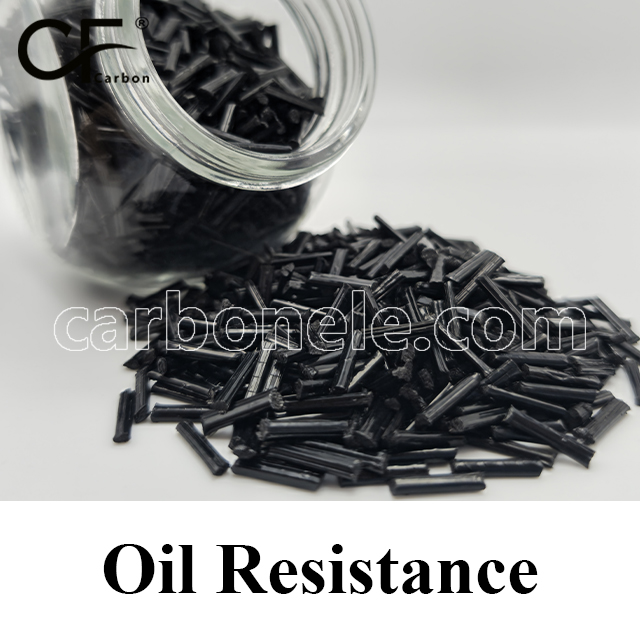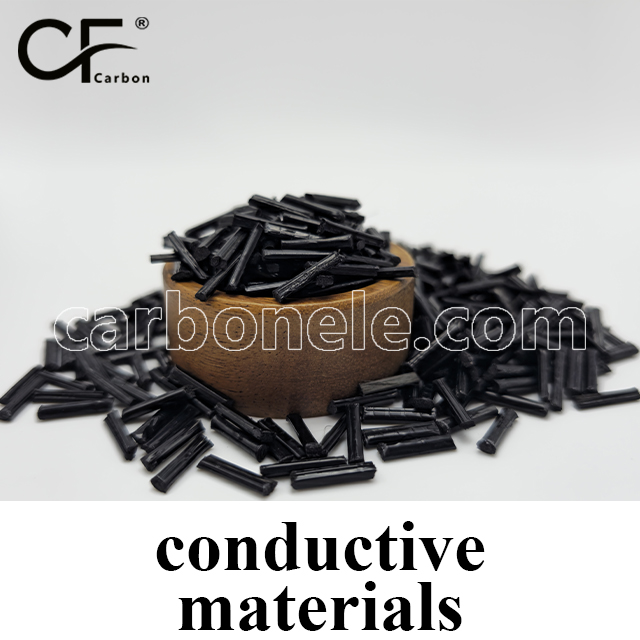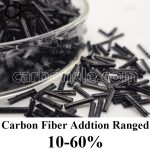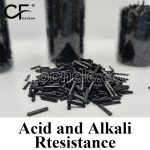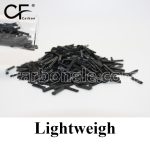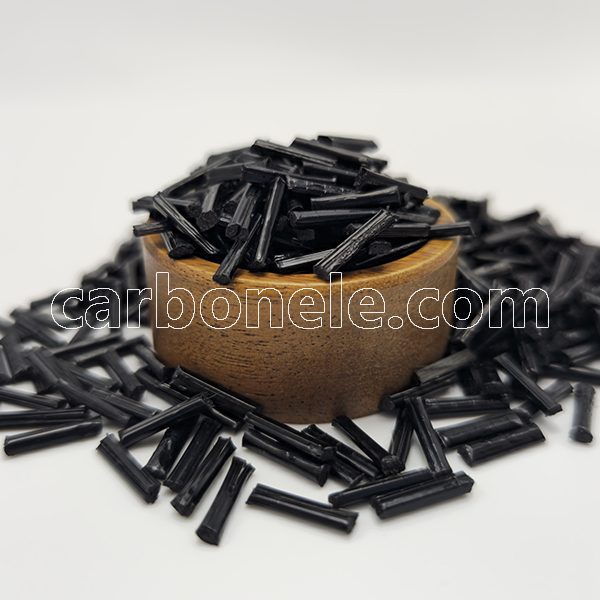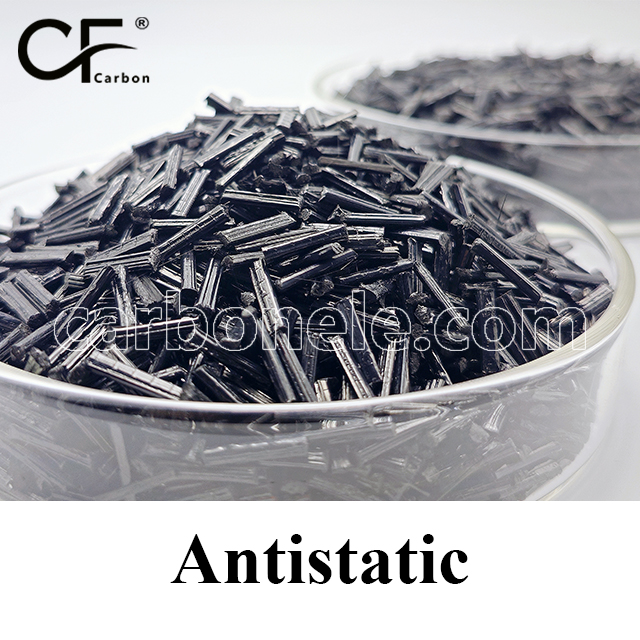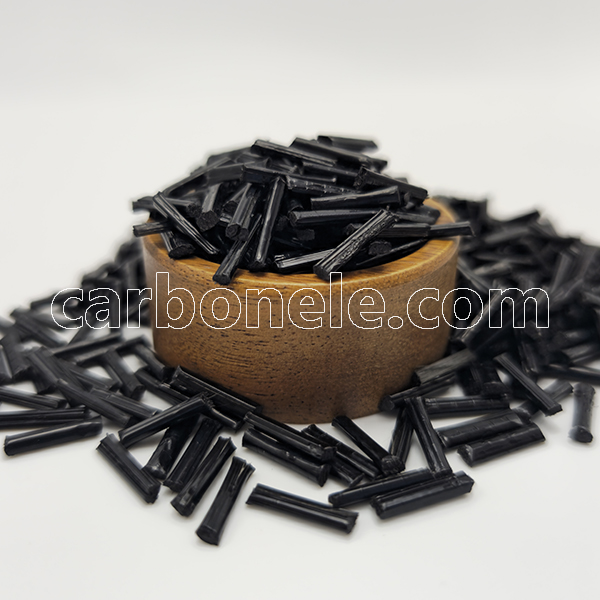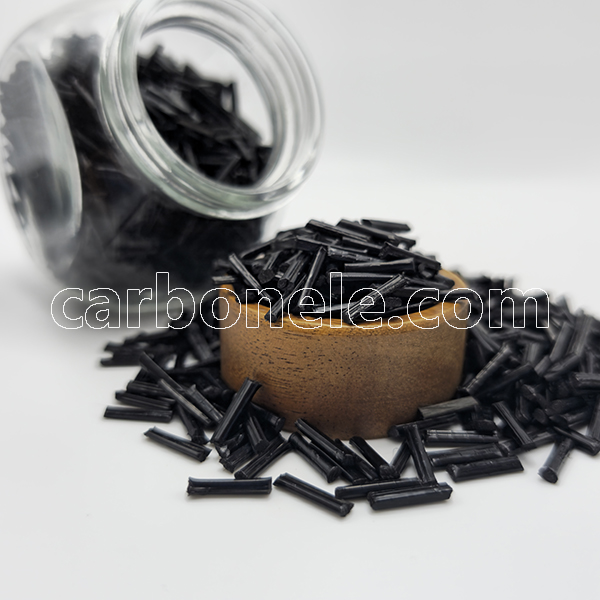PA66-LCF30 is a high performance engineering thermoplastic based on polyamide 66 (PA66) reinforced with 30% long carbon fiber (LCF). It offers exceptional strength, stiffness, and thermal stability, making it ideal for replacing metal in high load structural components across automotive, industrial, and electronic applications requiring long term durability and fatigue resistance.

Impact-resistant PA66-LCF30 engineering applications
- Model number: PA66-LCF-BCA3
- Matrix Resin: Nylon6 6(Polyamide66) (PA66)
- Reinforcing Filler: Carbon fiber
- Appearance: Granules
- Grade: Injection/extrusion grade
- Packaging: 25kgs/bag
PA66-LCF30: Ultra-High Strength Long Carbon Fiber Reinforced Polyamide 66 for Demanding Structural and Thermal Applications
PA66-LCF30 is a premium engineering grade thermoplastic based on polyamide 66 (PA66), reinforced with 30% long carbon fiber (LCF). This advanced composite material is engineered to meet the highest performance demands in structural components, where extreme strength, stiffness, and thermal resistance are critical. The long carbon fiber reinforcement significantly enhances mechanical performance, dimensional precision, and fatigue resistance—making it a powerful alternative to metal in many load bearing applications.
By leveraging long fibers rather than short or chopped variants, PA66-LCF30 ensures more efficient stress transfer across the matrix, improved resistance to mechanical shock, and reduced long term deformation such as creep and warping. It is ideally suited for high performance automotive, industrial, mechanical, and electronic systems operating under thermal, dynamic, or chemical stress.
Key Mechanical Properties
Tensile Strength: ≥ 145 MPa
Flexural Strength: ≥ 190 MPa
Notched Impact Strength: ≥ 12 kJ/m²
The high 30% LCF content provides outstanding mechanical reinforcement—offering more than 70% improvement over unfilled PA66 in strength and rigidity while maintaining good impact absorption. The long carbon fibers create a resilient internal network that distributes loads more uniformly, minimizing stress concentrations that could lead to fatigue or fracture.
Thermal and Chemical Resistance
Heat Deflection Temperature (HDT): Approx. 140°C
Long Term Service Temperature: Up to 130°C
Chemical Resistance: Excellent resistance to oils, greases, fuels, and weak acids; moderate resistance to alkalis; not suitable for concentrated oxidizing agents or mineral acids
PA66-LCF30 delivers consistent mechanical integrity even under sustained exposure to elevated temperatures, making it suitable for engine adjacent environments, industrial machinery housings, or equipment that cycles through heating phases.
Wear Resistance and Processability
Wear Resistance: Extremely high – suitable for continuous motion and high pressure friction components
Processing Methods: Injection molding (requires LCF capable feeding systems), compression molding
Processing Notes: To preserve fiber length and optimize mechanical output, use low shear settings and hardened tooling. Uniform dispersion of fibers is essential for consistent product performance.
The extended carbon fibers embedded in PA66’s matrix provide substantial improvements in wear life and dimensional retention during repeated mechanical interaction. As a result, PA66-LCF30 is an ideal solution for sliding interfaces, bearings, and articulated joints that are subject to frequent motion.
Environmental Stability
Water Absorption: Significantly lower than standard PA66
Dimensional Stability: Excellent – retains form and function in environments with humidity and temperature fluctuations
Traditional PA66 is prone to moisture absorption, which leads to expansion and property shifts. However, PA66-LCF30’s high LCF content counteracts this by reducing hydrophilicity and providing a reinforcing matrix that limits expansion, shrinkage, or shape distortion—especially important for precision parts in mechanical assemblies or humid settings.
Typical Applications
PA66-LCF30 is specifically formulated for high load, high performance applications where durability, dimensional stability, and mechanical resilience are paramount. Target markets and components include:
Automotive:
Structural supports and brackets in engine compartments
Under the hood mounts and lightweight reinforcements
Chassis or underbody connection elements replacing metal
Industrial:
High cycle robotic arms, joints, and rotating linkages
Sliding guides, bearing blocks, and load distributing mechanical supports
Structural frames for machinery operating in thermally intense settings
Electronics & Consumer Devices:
Stiff structural frames and housings in electronic assemblies
Mounts and enclosures subject to heat and vibration
Mechanically active components requiring tight tolerances
PA66-LCF30 Performance Summary
| Property | Value/Description |
|---|---|
| Carbon Fiber Content | 30% (Long Carbon Fiber) |
| Tensile Strength | ≥ 145 MPa |
| Flexural Strength | ≥ 190 MPa |
| Notched Impact Strength | ≥ 12 kJ/m² |
| Heat Deflection Temp. | Approx. 140°C |
| Long Term Service Temp. | Up to 130°C |
| Chemical Resistance | Excellent, except strong acids/oxidizers |
| Water Absorption | Lower than unfilled or short fiber PA66 |
| Processing Methods | Injection molding, compression molding |
| Wear Resistance | Very high – suitable for dynamic/frictional parts |
If you want to get more information about PA66-LCF30, you can vist our Youtube.
Click here to contact us.
Strength between PA66 and PA66-CF
Compared to unreinforced PA66, PA66-CF (carbon fiber reinforced) offers significantly higher strength and stiffness. The addition of carbon fiber increases tensile and flexural strength, enhances dimensional stability, and reduces deformation under load. While standard PA66 provides good toughness and impact resistance, PA66-CF materials are better suited for structural and high-stress applications where superior mechanical performance is required.
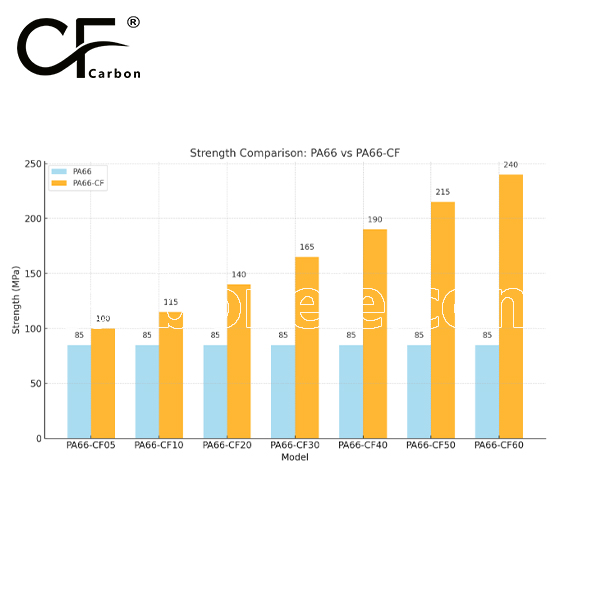
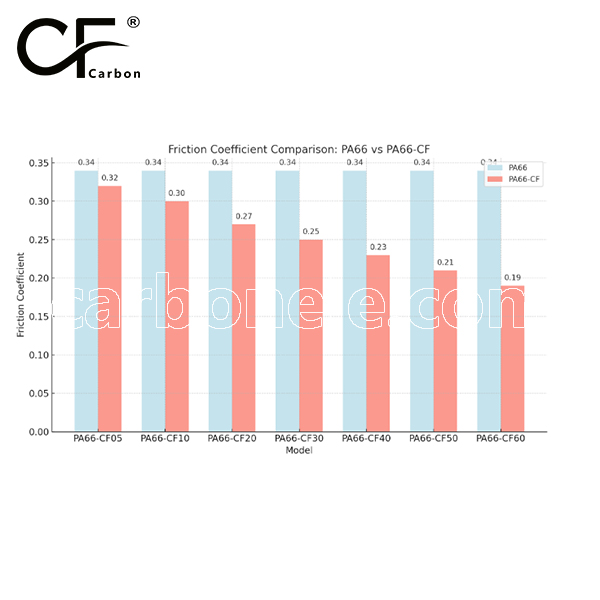

Frequently Asked Questions
Carbon (Xiamen) New Material Co., Ltd. aims to provide buyers with "one-stop" worry-free high-quality services. Here you can find all information about carbon fiber engineering plastics. If you still have questions, please send us an email for consultation!
-
How can I contact the manufacturer of a product that interests me?
When you find a product you are interested in, you can contact the manufacturer directly by sending an email and we will get back to you as soon as possible.
-
How do I find the products that interest me?
All you need to do is enter the keyword, product name in the search window and press the Enter key on your keyboard. Your search results page will then be displayed. You can also search within the product category pages on the home page. Each category is divided into subcategories, allowing you to refine your search and find products that interest you.
-
Where will I find a buying guide?
Please contact our after-sales service directly and we will provide you with a comprehensive operating guide.
-
What are CF Reinforced Thermoplastic Composites?
CF Reinforced Thermoplastic Composites are materials where carbon fibers are incorporated into a thermoplastic matrix. They combine the strength and stiffness of carbon fibers with the processability and recyclability of thermoplastics. For instance, they are used in automotive parts like bumper beams.
-
What are the benefits of CF Reinforced Thermoplastic Composites over traditional composites?
The key benefits include faster production cycles, easier recyclability, and better impact resistance. They also offer design flexibility. An example is in the manufacturing of consumer electronics casings where complex shapes can be achieved more easily.
-
How are CF Reinforced Thermoplastic Composites processed?
Common processing methods include injection molding, extrusion, and compression molding. Injection molding is widely used for mass production. For example, in the production of small components for the medical industry.
-
What industries use CF Reinforced Thermoplastic Composites?
They are utilized in aerospace, automotive, medical, and sports equipment industries. In aerospace, they can be found in interior components. In the medical field, they might be used in prosthetics.
-
How does the carbon fiber content affect the properties of the composites?
Higher carbon fiber content generally leads to increased strength and stiffness but may reduce ductility. A moderate content is often balanced for specific applications. For example, a higher content might be preferred in structural parts of a race car.
-
What are the challenges in using CF Reinforced Thermoplastic Composites?
Challenges include higher material costs, complex processing equipment requirements, and ensuring uniform fiber dispersion. Issues with adhesion between the fibers and the matrix can also arise. An example is in achieving consistent quality in large-scale production.








